The US dollar strengthened, while US equities pulled back yesterday after data showed that the US CPIs for October accelerated more than the forecasts suggested. The latest rally in inflation may not be transitory after all and may have increased speculation that the Fed may need to start raising interest rates faster, perhaps as soon as the tapering is over.
Will Accelerating Inflation Result in Faster Tightening by the Fed?
The US dollar traded higher against all the other major currencies on Wednesday and during the Asian session Thursday, gaining the most versus GBP, JPY, EUR, and NZD in that order.
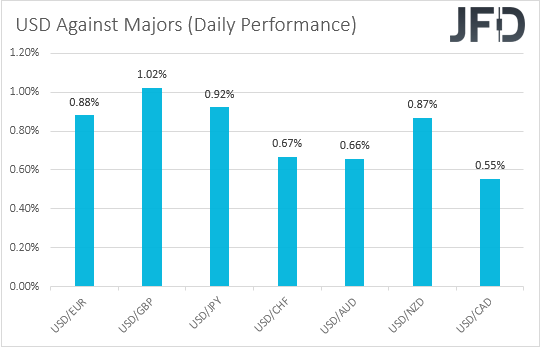
The strengthening of the US dollar suggests that markets may have traded in a risk-off fashion yesterday, but the fact that the Japanese yen was the second loser in line says otherwise. Therefore, in order to get a clearer picture with regard to the broader investor morale, we prefer to turn our gaze to the equity world.
There, major EU indices traded higher, but later in the day, all three of Wall Street’s main indices fell notably, with the NASDAQ losing the most. However, during the Asian session today, sentiment improved again, with only one index (of those under our radar) trading south.
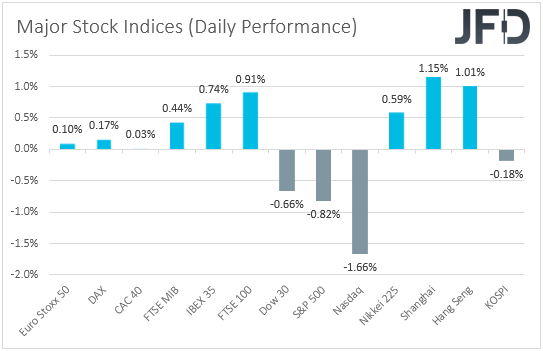
Yesterday, the highlight on the economic agenda was the US CPIs for October. The headline rate rose by more than anticipated, hitting a 31-year high in YoY terms. Specifically, it jumped to +6.2% YoY from +5.4%, instead of rising to +5.8% as the forecast suggested.
Underlying inflation accelerated by more than anticipated as well, with the core rate hitting +4.6% YoY, at a time when the consensus was at +4.3%. In our view, this enhances the idea that the latest rally in inflation may not be as transitory as the Fed has previously thought, and with both the CPI rates moving dangerously away from the Fed’s objective of 2%, it rings alarm bells for faster tightening.
Remember, that at its previous gathering, the Fed began its tapering process as expected, and although Fed Chair Powell said that they will stay patient on interest rates, he did not close the door to the possibility of beginning the liftoff just after the tapering is over.
Despite officials maintaining the “transitory” language in their statement, they were not so adamant on that view this time around. Therefore, we believe that the further acceleration in inflation will eventually force them to abandon that wording, and perhaps start thinking to begin raising interest rates sooner.
Market participants are in favor of faster hikes as well. According to the Fed funds futures, ahead of the data, they were anticipating the first 25 bps hike to be delivered in September next year, but following the higher CPI rates, they brought that timing forth to August.
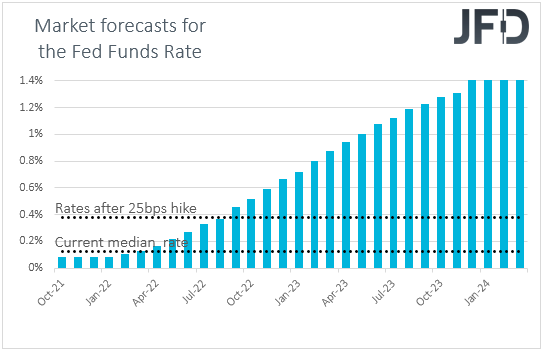
That’s why the dollar was the stellar outperformer among the major currencies, and that’s why stocks pulled back during the US session. That said, we stick to our guns that the retreat is likely to prove to be short-lived and that a rebound is possible soon.
In our view, up until now, data have been suggesting that the US economy has fared with the latest supply shortages very well, and if they continue to do so, market participants may stay willing to buy stocks, despite expectations of faster rate increases. After all, they may have already digested the idea of central bank tightening.
Overnight, we had another top-tier release, and this was Australia’s employment report for October. The unemployment rate jumped by more than anticipated, from 4.6% to 5.2%, instead of 4.8%, while the net change in employment revealed another decline in new jobs.
As we noted yesterday, a soft employment report could be a reason for Aussie traders to push further back their Reserve Bank of Australia (RBA) hike expectations, and judging by the slide in the currency at the time of the release, this is what may have happened.
As for today, during the early European session, we already got the UK preliminary GDP for Q3, which also disappointed, slowing by more than expected. Despite Bank of England (BoE) Governor Bailey saying that he and his colleagues are still on a path towards raising interest rates.
We believe that today’s weaker than expected data add to speculation that a rate increase may not come in December, and perhaps be delivered in the first months of the new year. This is likely to keep the pound under selling interest. Remember that, despite the strong recovery following Bailey’s remarks, we maintained a bearish view on GBP/USD, and yesterday’s fall proved us right.
EUR/USD – Technical Outlook
EUR/USD fell sharply yesterday, breaking below the key support zone of 1.1524, which had been acting as a floor since Oct. 6. It also fell below the psychological round number of 1.1500, to eventually hit the 1.1465 barrier, marked by the inside swing high of July 20, 2020.
Overall, the pair continues to trade below the downside resistance line drawn from the high of May 25, while yesterday’s fall has confirmed a forthcoming lower low on the daily chart. This keeps the outlook negative in our view.
Even if the rate rebounds somewhat to correct a portion of yesterday’s steep decline, we would see decent chances for the bears to jump back into the action from near the 1.1524 zone and shoot for another test at 1.1465.
If they manage to overcome that level this time around, this will confirm another forthcoming lower low and may see scope for declines towards the 1.1370 zone, defined as a support by the low of July 17, 2020.
In order to abandon the bearish case and start examining the case of a bullish reversal, we would like to see a strong recovery above the 1.1694 zone, marked by the high of Oct. 28.
This could confirm the break above the downside line taken from the high of May 25, and could encourage advances towards the 1.1749 zone, which provided resistance between Sept. 21 and 23, the break of which could target the high of Sept. 17, at 1.1790.
If the bulls are not willing to stop there either, then we could see them climbing towards the 1.1837 territories, which acted as a temporary ceiling between Sept. 9 and 15.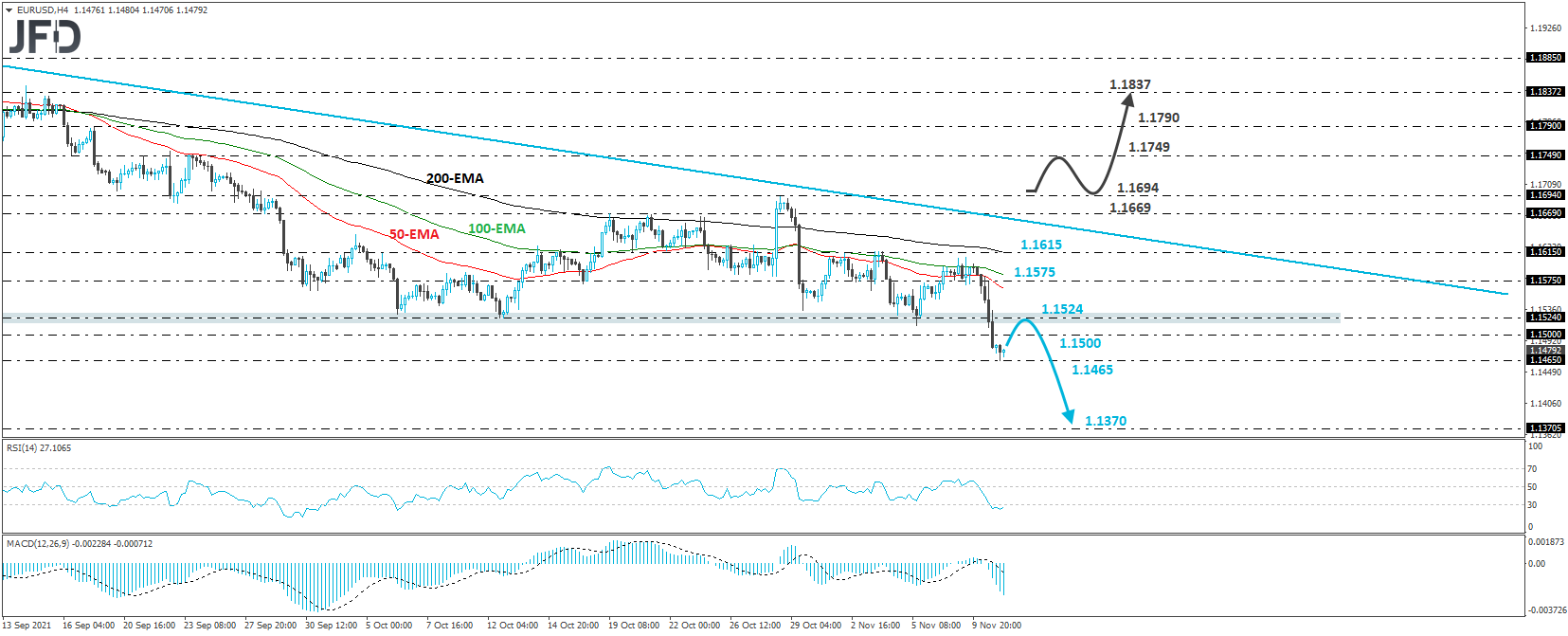
AUD/CAD – Technical Outlook
AUD/CAD traded lower as well yesterday, after it hit resistance at 0.9173. That said, the slide stopped near the 0.9133 zone, defined as a support by the low of Oct. 13.
Overall, this pair is also printing lower lows and lower highs, as marked by a downside resistance line drawn from the high of Nov. 2. Therefore, with all that in mind, we will consider the short-term picture to be negative.
A break below 0.9133 may invite more bears into the action, who could push towards the 0.9104 barrier, marked by the lows of Oct. 8 and 11. If they don’t stop there, then a break lower could set the stage for extensions towards the 0.9065 territory, defined as a support by the low of May 27, 2020.
We will start examining the bullish case upon a break above the 0.9205 zone. This could confirm the break above the aforementioned downside line and perhaps pave the way towards Monday’s high, at 0.9250.
If the bulls are strong enough to overcome that hurdle as well, then we could see them aiming for the inside swing low of Nov. 1, at 0.9282.
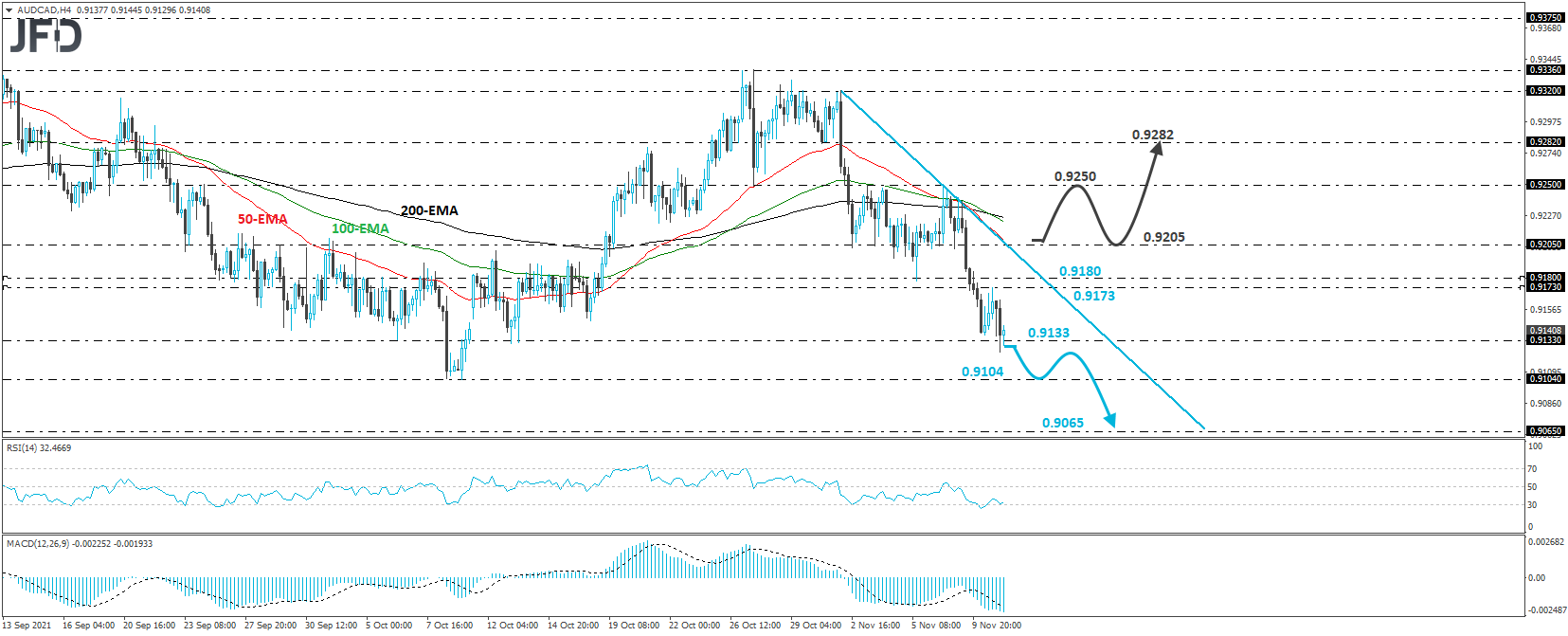
As for the Rest of Today’s Events
We don’t have any other top-tier indicators on the calendar for the rest of the day, but we will get to hear from two European Central Bank (ECB) officials, and those are Chief Economist Philip Lane and Executive Board member Isabel Schnabel.
